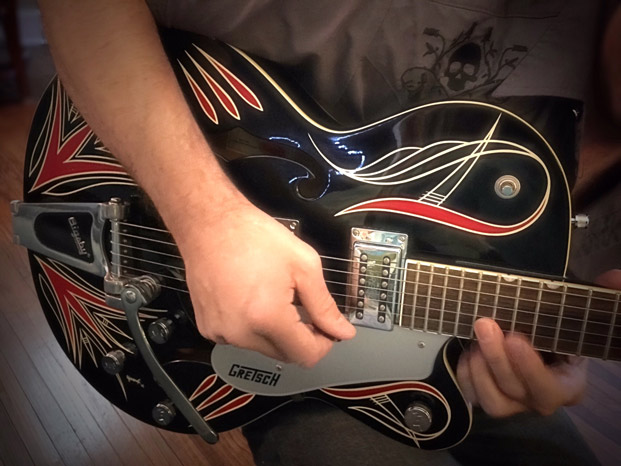Shaping Up: Dominant Double Stops for Guitar

When learning how to play jazz guitar, we often spend time working out scales, arpeggios and single-note riffs, as well as chord shapes and common progressions.
But what about those sounds in the middle of these two sonic poles—double stops? Double stops are a great way to add a new texture to your jazz guitar chord soloing ideas, to dominant 7th chords (as in this lesson), or to any harmony you are exploring.
Also, they are less demanding technically, so they can juice up your chord-soloing lines at faster tempos when full chord shapes are too tough to grab on the neck. In today’s lesson, we’ll be exploring two of my favorite shapes for playing double stops over dominant 7th chords on guitar, as well as checking out a sample lick you can use as a stepping stone to improvising with these ideas on your own in a jam or gig situation.
Dominant Double Stop Shapes, Part 1
To begin, let’s take a look at double stops built around an A13 chord, with the root on the fifth fret of the sixth string, or the fifth fret of the first string, depending on how you want to look at it. Since this chord is used a lot in jazz guitar, 13th chords with no root, we’ll use that as our point of reference for these double-stop ideas, killing two birds with one stone as you work on double stops and rootless chords in the woodshed.
Try practicing and memorizing these double-stop fingerings in various keys around the fretboard, starting with the key of A and moving on from there. Having a handle on these shapes in various keys will allow you to quickly and comfortably apply them to your improvised solos in ii V I progressions as well as over jazz blues progressions and standards such as “Watermelon Man” and “Killer Joe,” both built around 7th-chord harmonies.

When you can play these double stops comfortably, try putting on an A13 vamp and soloing over that chord using these double stops to build your lines and phrases. From there, repeat this exercise in the other 11 keys in order to work these shapes in all locations around the fretboard.
Dominant Double Stop Shapes, Part 2
As well as learning dominant double stops based around the sixth/first string root chord, as you did in the first example, you can also learn them based around a fifth-string root chord. Just like you saw in the first example, here there is no root note in the chord shape that I’m basing my double stops from, but you can think of the note D as being on the fifth string, fifth fret and use that as a reference.
Playing rootless chords is something many jazz players do in their comping and chord-soloing ideas, so if this is new to you, check out my lesson "9th Chords Made Easy” for more information on the subject.

Once you have these shapes under your fingers, try jamming over a D7 vamp and soloing using only these double stops to build your lines. From there, you can take these fingerings to all 12 keys and then practice soloing over a jazz blues chord progression using these, and the first set of double-stop shapes to build your improvised lines and phrases.
Dominant Double Stop Lick
To help you get started with these double-stop fingerings over 7th chords, here's a sample lick you can learn over the first four bars of an A blues. I’ve used an A pedal note, the single-note A that keeps coming back, as this is a common technique used by jazz guitarists when playing double stops, and one you can explore further in your own practicing.

As you can see, working out these two positions of 7th double stops will give you a cool, organ sound in your jazz blues guitar lines and comping. Check out these shapes this week in the practice room and see where they lead you in the woodshed and out on the bandstand. Do you have a question about dominant double stops?
Share your thoughts in the COMMENTS section below.
Matt Warnock is the owner of mattwarnockguitar.com, a free website that provides hundreds of lessons and resources designed to help guitarists of all experience levels meet their practice and performance goals. Matt lives in the UK, where he is a lecturer in Popular Music Performance at the University of Chester and an examiner for the London College of Music (Registry of Guitar Tutors).
Get The Pick Newsletter
All the latest guitar news, interviews, lessons, reviews, deals and more, direct to your inbox!
Matt Warnock is the owner of mattwarnockguitar.com, a free website that provides hundreds of lessons and resources designed to help guitarists of all experience levels meet their practice and performance goals. Matt lives in the UK, where he teaches Skype guitar students all over the world, and is an examiner for the London College of Music (Registry of Guitar Tutors).
“There are so many sounds to be discovered when you get away from using a pick”: Jared James Nichols shows you how to add “snap, crackle and pop” to your playing with banjo rolls and string snaps
Don't let chord inversions bamboozle you. It's simply the case of shuffling the notes around







![Joe Bonamassa [left] wears a deep blue suit and polka-dotted shirt and plays his green refin Strat; the late Irish blues legend Rory Gallagher [right] screams and inflicts some punishment on his heavily worn number one Stratocaster.](https://cdn.mos.cms.futurecdn.net/cw28h7UBcTVfTLs7p7eiLe.jpg)


